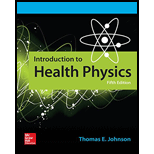
Concept explainers
(a)
The relative proportions of the two groups after passing through 25 cm of water.
(a)
Answer to Problem 5.35P
The relative proportions of the two groups after passing through 25 cm of water is,
Explanation of Solution
Given:
Energy,
Energy,
Thickness,
Cross-section,
Cross-section,
Cross-section,
Cross-section,
Formula used:
The intensity of gamma beam through the absorber curve is,
Where,
x =Thickness
Calculation:
The number of Hydrogen atoms per cm3 is,
The number of Oxygen atoms per cm3 is,
For Energy,
The intensity is given by
For Energy,
The intensity is given by
The relative proportions of the two groups after passing through 25 cm of water is,
Conclusion:
The relative proportions of the two groups after passing through 25 cm of water is,
(b)
The relative proportions of the two groups after passing through a slab of lead of the same density thickness.
(b)
Answer to Problem 5.35P
The relative proportions of the two groups after passing through 25 cm of water is
Explanation of Solution
Given:
Energy,
Energy,
Density thickness,
Cross-section,
Cross-section,
Cross-section,
Cross-section,
Cross-section,
Cross-section,
Cross-section,
Cross-section,
Formula used:
The intensity of gamma beam through the absorber curve is,
Where,
x =Thickness
The thickness is given by,
Calculation:
The thickness is given by,
For energy 1 MeV
Number of Pb-204 atoms are,
So,
Number of Pb-206 atoms are,
So,
Number of Pb-207 atoms are,
So,
Number of Pb-208 atoms are,
So,
Thus,
The intensity is given by:
For energy 10 MeV
Number of Pb-204 atoms are,
So,
Number of Pb-206 atoms are,
So,
Number of Pb-207 atoms are,
So,
Number of Pb-208 atoms are:
So,
Thus,
The intensity is given by
The relative proportions of the two groups after passing through 25 cm of water is,
Conclusion:
The relative proportions of the two groups after passing through 25 cm of water is:
Want to see more full solutions like this?
Chapter 5 Solutions
Introduction To Health Physics
- What is the dose in mSv for: (a) a 0.1 Gy xray? (b) 2.5 mGy of neutron exposure to the eye? (c) 1.5 mGy of exposure?arrow_forwardThe electrical power output of a large nuclear reactor facility is 900 MW. It has a 35.0% efficiency in converting nuclear power to electrical. (a) What is the thermal nuclear power output in megawatts? (b) How many 235U nuclei fission each second, assuming the average fission produces 200 MeV? (c) What mass of 235U is fissioned in one year of fullpower operation?arrow_forwardData from the appendices and the periodic table may be needed for these problems. Show that the activity of the 14C in 1.00 g of 12C found in living tissue is 0.250 Bq.arrow_forward
- (a) How many 239Pu nuclei must fission to produce a 20.0kT yield, assuming 200 MeV per fission? (b) What is the mass of this much 239Pu?arrow_forwardThe electrical power output of a large nuclear reactor facility is 900 MW. It has a 35.0% efficiency in converting nuclear power to electrical power. What is the thermal nuclear power output in megawatts? How many 235U nuclei fission each second, assuming the average fission produces 200 MeV? What mass of 235U is fissioned in 1 year of full-power operation?arrow_forwardA neutron generator uses an (source, such as radium, to bombard beryllium, inducing the reaction 4He+9Be12C+n. Such neutron sources are called RaBe sources, 0r PuBe sources if they use plutonium to get the (s. Calculate the energy output of the reaction in MeV.arrow_forward
 College PhysicsPhysicsISBN:9781938168000Author:Paul Peter Urone, Roger HinrichsPublisher:OpenStax College
College PhysicsPhysicsISBN:9781938168000Author:Paul Peter Urone, Roger HinrichsPublisher:OpenStax College Modern PhysicsPhysicsISBN:9781111794378Author:Raymond A. Serway, Clement J. Moses, Curt A. MoyerPublisher:Cengage Learning
Modern PhysicsPhysicsISBN:9781111794378Author:Raymond A. Serway, Clement J. Moses, Curt A. MoyerPublisher:Cengage Learning Physics for Scientists and Engineers with Modern ...PhysicsISBN:9781337553292Author:Raymond A. Serway, John W. JewettPublisher:Cengage Learning
Physics for Scientists and Engineers with Modern ...PhysicsISBN:9781337553292Author:Raymond A. Serway, John W. JewettPublisher:Cengage Learning Principles of Physics: A Calculus-Based TextPhysicsISBN:9781133104261Author:Raymond A. Serway, John W. JewettPublisher:Cengage Learning
Principles of Physics: A Calculus-Based TextPhysicsISBN:9781133104261Author:Raymond A. Serway, John W. JewettPublisher:Cengage Learning
 University Physics Volume 3PhysicsISBN:9781938168185Author:William Moebs, Jeff SannyPublisher:OpenStax
University Physics Volume 3PhysicsISBN:9781938168185Author:William Moebs, Jeff SannyPublisher:OpenStax





